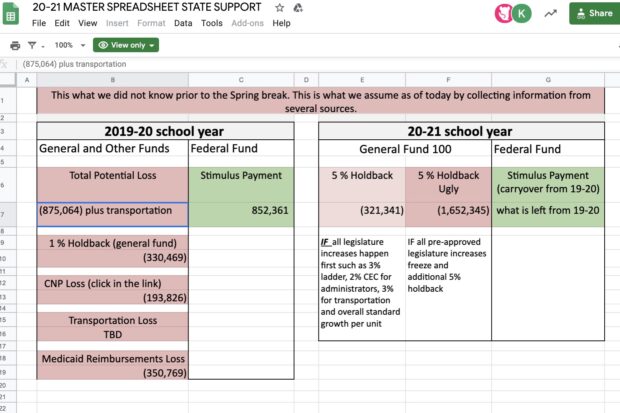Citing lessons learned from the Great Recession, the Kuna School District decided last week to furlough more than 100 classified employees to combat budget shortfalls projected for this year and next. No teachers were furloughed.
Because of the novel coronavirus, Gov. Brad Little ordered Idaho institutions to take a 1 percent funding reduction for the remainder of the 2019-20 fiscal year. For the Kuna School District, which receives close to $30 million in state funding, that holdback is $330,469.

But Kuna is reporting a far deeper deficit, including more than $500,000 of payments in child nutrition and Medicaid reimbursements, adding up to a total of $875,000 of shortfall for this fiscal year.
Then there’s next year to deal with. While the state has not officially ordered any budget holdbacks for the 2020-21 school year, Kuna is budgeting for a potential 5 percent budget reduction, which could leave the district up to $1.6 million short.
“Knowing that’s coming … we tried to close that gap in funding for this year,” Superintendent Wendy Johnson said in a video segment taped by the district.
Kuna’s furloughs mirror a similar decision in Lake Pend Oreille in early April. That district furloughed 59 classified employees in response to Little’s holdbacks, the Bonner County Daily Bee reported.
Kuna will save approximately $750,000 by furloughing classified employees for the remainder of the school year. The district voted to furlough 121 classified employees, but spokeswoman Allison Westfall said more volunteered to take pay cuts. As of Tuesday, the official furlough count was 159.
Kuna has a fund balance (essentially, savings) of about $2.5 million. Westfall says the district doesn’t want to spend too much of this money, because Kuna needs the fund balance to have cash available, and to help reduce the bond cost for building new schools.
A federal stimulus package is expected to help school districts offset coronavirus-related costs. The district estimates it could receive 852,361 in federal stimulus money, which would cover the majority of its projected 2019-20 losses.
But the district doesn’t know if that money would have covered staff salaries, Westfall said, or exactly when it will arrive.
“Without clear guidance and information, we didn’t feel able to make decisions for this current year,” Westfall wrote in an email.
Greg Wilson, senior education policy adviser for Little, says there is no firm decision on budget holdbacks for next school year. While it’s too early to know what exactly is going to happen with the economy, school districts are already starting to set budgets for next fiscal year, which begins July 1. He has been working with districts to try and help them prepare.
Little’s office has asked state agencies to plan for a potential 5 percent cut. It’s a “prudent, conservative estimate at this point, when there are a lot of unknowns,” Wilson said.
“We’re trying to figure out what kind of guidelines (districts) need moving forward,” Wilson said. “The big concern we have is they’re going into budget setting very quickly. We need to provide some kind of guidelines for a very, very uncertain environment. We really don’t know what the economic situation is going to look like next year.”
With uncertainty ahead, Johnson said Kuna is proactively cost-cutting, a lesson carried over from the Great Recession a decade ago.
“The big lesson learned: Whatever we could save in the current year would help us into the next year,” she said. “We decided to save what we could in the time that we have left by furloughing some of our staff.”
The district says the move will allow furloughed staff to claim enhanced unemployment benefits under expanded, coronavirus-related unemployment guidelines.
She expects furloughed employees — paraprofessionals, behavioral interventionists, bus drivers and office staff — to be back on the job when kids are back to school.
“We have not terminated people,” she said. “I’m seeing this as a pause to people’s employment, but they’re still a part of our team.”
Watch Johnson’s address here, at the 13 minute mark.
